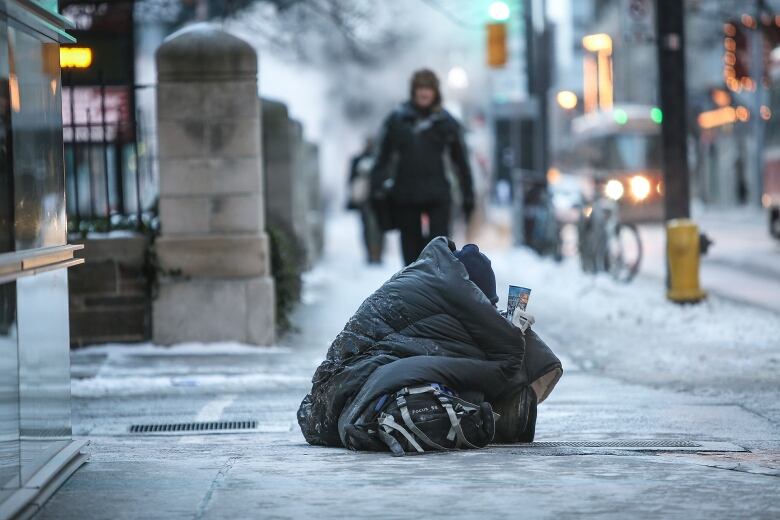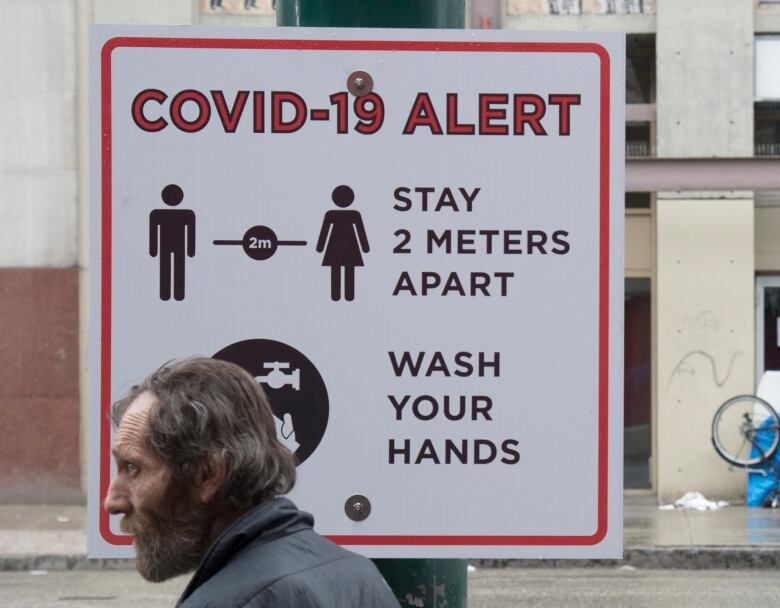Why communities need to move fast, get creative to protect homeless from COVID-19
There is no precedent for these uncertain times, and our solutions require unconventional approaches

This column is an opinionby Dr. Jaspreet Khangura, Dr. Meera Burns, Dr.Naheed Dosaniand Dr.Sahil Gupta.For more information about CBC's Opinion section, please see theFAQ.
In the battle against COVID-19, we are demanding the biggest sacrifices from people with the fewest resources and the most to lose.
The homelessness crisis has long-existed in Canada, and the current COVID-19 pandemic highlights the gaps in our health and social systems. At a COVID-19 assessment centre in the Greater Toronto Area on Monday at 6 p.m., for example, Ralph comes in with a cough and sore throat. At this centre, he doesn't qualify for testing and is advised to self-isolate.
"I'm homeless, so I don't have a lot of options. I can't go back to the shelter and expose my friends," Ralph tells us. "I'll go sleep on the street for a few days."
It is a cool -5 C outside and Ralph is giving up a warm bed to protect our community. How can this 68-year-old gentleman survive in self-isolation outside for two weeks?

Across the country, Tim has developed a new cough and feels short of breath. He has been sleeping in local shelters for the past six months after a stroke left him with memory problems and paralysis of his right arm. He previously worked as a courier, but lost his job after the stroke and was unable to pay the rent for his basement apartment.
With a new cough and symptoms, Tim is not able to access the shelter he usually visits to receive support. Where does he go?
His drop-in directs him to get checked out in the emergency room. He is tested for COVID-19 in the ER and admitted for self-isolation an expensive and unsustainable solution until his results will be available many days later.
As of March 30, Toronto had confirmed four COVID-19 positive cases in individuals experiencing homelessness. There will undoubtedly be more in the coming weeks.
Crowded spaces are the enemy of infection control during a pandemic. At many shelters and drop-ins across the nation, makeshift dividers precariously separate mattresses arranged less than the two metres apart recommended by Public Health to prevent COVID-19 spread. Lineups for entry to the shelters and limited bathroom spaces fuel overcrowding and multiple close contacts.
Around the world, these are the kinds of conditions that fuel exponential disease spread.

We need a coordinated response to guide the approach to testing and cohorting individuals experiencing homelessness.
The Canadian Alliance to End Homelessness determined that just one in four communities across the country has been able to implement a plan to prevent and manage COVID-19 for the homeless. So how do we address this urgent issue in the midst of a pandemic?
The Canadian Network for Health and Housing of People Experiencing Homelessness has released a framework in response to COVID-19 that offers an approach. Here are some of the most urgent recommendations:
Identifythose at high risk, test accordingly
The report emphasizes that the people who are sickest and most likely to be affected should be identified in order to start self-isolation and aggressive physical distancing measures pro-actively. It also recommends testing widely for those at highest risk.
According to a U.S. report, homeless patients are at double the risk of hospitalization, and two to three times the risk of death from COVID-19, compared to the general population. Canada faces a similar situation because of an aging homeless population with a higher burden of chronic illness.

Due to limitations in our ability to test widely (lack of swabs, lab processing time), we have had to develop criteria for testing. Unfortunately, these criteria do not always take into account individual, social and environmental risk factors. Ralph from Toronto is at much higher risk because of his age, environment, and co-morbidities than a similar-aged person with those symptoms who is living at home with no chronic medical issues, for example.
Risk- stratification in this community is essential to target testing efforts and prevent disease spread.
Develop a plan for the 'the wait'
What happens after testing is still a bit murky.
While the report recommends cohorting grouping test-positive patients separately from test-negative patients the reality is that delays in testing and test results, which can take up to five days and maybe more in some areas, make it impossible to separate these groups in the existing shelter environments.
Where do homeless patients go while waiting for test results? Or those like Ralph, who have to self-isolate for 14 days?
These gaps in our pandemic planning will constitute the difference between flattening the curve or not.
So what happens to people like Tim and Ralph?
Hospital admissions for social-isolation are not cost effective or sustainable. Emergency shelters are adapting as best they can to support public health and safety, in many cases due to necessity, by reducing capacity, but more work is needed.
It's time we get creative with solutions.
- California with estimates of COVID-19 infection expected to be as high as 56 per cent among the homeless population, local authorities have started to respond. California Governor Gavin Newsom allocated $150 million to help move the homeless into sheltered spaces.
- Edmonton the local EXPO centre opened on March 24 to serve as a temporary overflow shelter. People like Tim are now being directed here to self-isolate and wait for results instead of taking up limited hospital beds. Space is also available during the day for appropriate physical distancing for individuals without any symptoms.
- Montreal - the city is converting the old Royal Victoria Hospital to a COVID-19 isolation unit for homeless individuals.
- Toronto and Calgary these cities are in the process of organizing underutilized motel and hotel rooms to assist with self-isolation and physical distancing for homeless individuals. But this is just the beginning of a solution and cannot be implemented until meals, medications and harm reduction services are funded and coordinated.
- Virtual technologies are also being used byclinicians in some areas to deliver care to the homeless, but this only supports a subset of people with reliable internet and smartphone access.

There is no precedent for these uncertain times, and as such, our solutions will require unconventional approaches.
Furthermore, recognizing that people experiencing homelessness are at increased risk for contracting COVID-19, increasing testing access and resources will also go a long way towards flattening the curve. Without addressing current living situations, in all communities, physical distancing will not be effective.
One has to wonder, would we be in this situation now if every Canadian had access to affordable, safe and high-quality housing to begin with? Whatever solutions we come up with should undoubtedly be rooted in the spirit of ending the homelessness crisis for good, well beyond the span of the pandemic, because housing is a fundamental human right.
Inherently, we will need political will and leadership to mobilize resources and find solutions for implementation, both short and long-term, by our communities, health authorities and governments.
- This column is part of CBC's Opinion section. For more information about this section, please read ourFAQ.
Jaspreet Khangura is an emergency physician at an inner city hospital and trauma centre in Edmonton Alberta (Twitter: @JK_Khangura).
Meera Burns is a palliative care physician, general internist and health journalist in Toronto, Ontario (Twitter: @DrMeeraDalal).
Naheed Dosani is a palliative care physician providing care for homeless & vulnerably housed populations in Toronto (Twitter: @NaheedD).
Sahil Gupta is an emergency physician and health journalist in Toronto (Twitter: @bysahilgupta)













_(720p).jpg)


 OFFICIAL HD MUSIC VIDEO.jpg)
.jpg)



























































































